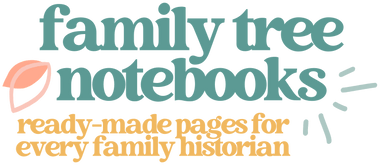
The most overwhelming thing about genealogy? We all have a lot of family.
Even if you don’t have a large living family, we all come from a HUGE pool of people, biologically speaking. You only have 2 biological parents but you have 4 biological grandparents and 8 biological great-grandparents. It goes on and on like this:
2nd great grandparents = 16 people
3rd great grandparents = 32 people
4th great grandparents = 64 people
5th great grandparents = 128 people
6th great grandparents = 256 people
7th great grandparents = 512 people
8th great grandparents = 1024 people
That’s just ten generations (which, by the way, is a whole lot more than people usually track in their genealogy). Ten generations, including you, equals 2047 people. I’m not saying this to discourage you from working on your family history, but I do want you to see how quickly things can get out of hand. You’ll get lost if you just start collecting documents and information on anyone in your biological map. We’re not even mentioning siblings, cousins, and so on!
The good news is that the chaos can be managed easily and I’m going to show you how.
STEP ONE: Pick a genealogy endpoint
Don’t go into your family history thinking you’re going to research absolutely everyone you’re related to. That’s a great goal and maybe you’ll get there eventually, but if you attempt to do that on day one you’re going to go bonkers. Personally, when I’m starting on a new family three, I like to go up six generations. This takes me from the root person all the way up to their 4th great-grandparents. I do as much research as I can to fill in all the gaps and only when I feel like I’ve really exhausted the search do I add another generation.
The benefit of this approach is that it fences you in and forces you to take a second and third look at available records for each person. It also gives you plenty to do, since that’s 127 people (including the root person).
If you don’t like the idea of stopping at a certain generation, you could also pick a very specific path and simply follow that chain, ignoring other ancestors for the time being. For example, you could research every male that passed down your surname. Even if you go back 20 generations (quite the challenge!) that would only be 20 people so it’s not overwhelming.

STEP TWO: Create an index
I created an index with the first six generations pre-printed on one side so I could just fill in names as I found them. We all have the same biological path to being on the planet so the index works for every tree. For families with notable adoptive or step-parents, I simply include their information with the ancestor they helped raise, rather than adding them to the index.

My index is also numbered and I use those numbers on every document that I attach to a particular ancestor. The benefit of my index is that it includes not only the relationship to the root person, but also which index number of the person they parented.
My index pages are available for sale by themselves but they’re also included in the full 200-page deluxe genealogy sets that I sell. There’s a blank index included with the pre-printed one just in case you want to move beyond the 4th great-grandparents.

STEP THREE: Number your ancestors
Numbering your ancestors is absolutely key to keeping things organized. Even if you think everything will stay in neat little chapters/notebooks/file folders/stacks, you want to put an ancestor number on every single document or photo you have. This way nothing ever pops up as a misfiled mystery.

Now, it’s possible to have a document that touches multiple ancestors, such as a census form or a marriage license. When that happens, I make a copy for each ancestor involved and add numbers to their individual copies. It helps that I can do this digitally since it’s a lot of copy/paste. For a full look at how I do my family history on my iPad, check out my Digital Genealogy 101 post.
I hope this post helped! Genealogy can be an overwhelming hobby but it really doesn’t have to make you crazy. Let me know if you have any questions about getting those ancestors organized!

